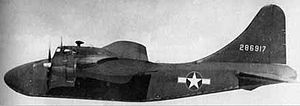C-76 Caravan
| C-76 Caravan | |
|---|---|
 |
|
| Role | Medium transport |
| National origin | United States |
| Manufacturer | Curtiss-Wright |
| First flight | May 3, 1943 |
| Status | Canceled |
| Primary user | United States Army Air Forces |
| Number built | 25 (11 prototypes, 5 production C-76, 9 revised YC-76A) |
The Curtiss-Wright C-76 Caravan (company designation CW-27) was an American all-wood military transport aircraft. The C-76 was intended as a substitute standard aircraft in the event of expected wartime shortages of light alloys. However, both prototype and production aircraft failed several critical flight and static tests, and after U.S. aluminum production proved sufficient for wartime defense requirements, orders for the C-76 were cancelled and production terminated.
In 1941, Curtiss-Wright was contracted by the United States Army Air Forces to design and construct an all-wood military transport aircraft, with performance specifications meeting or exceeding that of the Douglas C-47 Skytrain then in service.
The Curtiss-Wright CW-27 was designed by Curtiss-Wright's chief designer George A. Page, Jr. as a high-wing, twin-engine, cargo transport aircraft, utilizing plywood construction with a tricycle undercarriage. Though the British de Havilland Mosquito had successfully employed a ply construction using a balsa wood core and birch hardwood exterior, Curtiss-Wright engineers, using research provided by Forest Products Laboratory, rejected this approach, insisting instead on a ply construction of dense mahogany, which greatly increased the plane's weight. At Curtiss' request, Army Materiel Command laid in large supplies of mahogany, and a number of furniture manufacturers, including the Baldwin Piano Company, were subcontracted to build components for the aircraft, which would be assembled at Curtiss-Wright's new defense plant in Louisville, Kentucky.
A radial engine was mounted on each wing, and the aircraft was capable of carrying 23 personnel or a cargo payload. The Caravan had a nose section that swung out to the right to enable outsize loading, including a jeep or small artillery pieces.
The original contract called for 11 YC-76 preproduction aircraft, and the first aircraft would be built and tested at Curtiss-Wright's St. Louis, Missouri Division plant. Subsequently, orders for five C-76 production aircraft and nine revised YC-76As were placed by the USAAF, with line production to commence at the Curtiss-Wright plant in Louisville as well as a Higgins Aircraft factory in New Orleans, Louisiana. To keep the plywood flexible during construction the factory was kept hot and damp. The prototype YC-76 first flew on May 1, 1943.
...
Wikipedia
